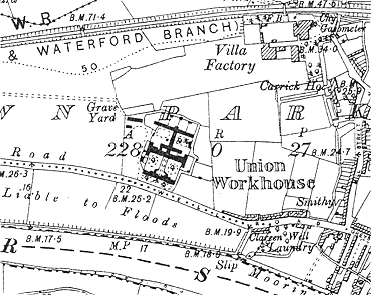Carrick-on-Suir, Co. Tipperary
Carrick-on-Suir Poor Law Union was formally declared on the 25th May 1839 and covered an area of 164 square miles. Its operation was overseen by an elected Board of Guardians, 21 in number, representing its 13 electoral divisions as listed below (figures in brackets indicate numbers of Guardians if more than one):
Co. Tipperary: Carrick-on-Suir (5), Grange Mockler, Kilcash.
Co. Kilkenny: Awming, Clonmore, Kilmaganny, Monkelly, Piltown (2), Tullahaught.
Co. Waterford: Kilmeadon, Mothell, Portlaw, Kilmoleran (4).
The Board also included 7 ex-officio Guardians, making a total of 28. The Guardians met each week on Saturday.
The population falling within the Union at the 1831 census had been 40,259 with divisions ranging in size from Kilmaganny (population 970) to Carrick-on-Suir itself (11,115).
The new Carrick-on-Suir Union workhouse was erected in 1840-1 on a seven-acre site at the north side of the Clonmel Road in Carrick-on-Suir. Designed by the Poor Law Commissioners' architect George Wilkinson, the building was based on one of his standard plans to accommodate 500 inmates. Its construction cost £5,168 plus £1,032 for fittings etc. The workhouse was declared fit for the reception of paupers on 10th May 1842, and received its first admissions on 8th July. The site location and layout are shown on the 1905 OS map below.

Carrick-on-Suir workhouse site, 1905.
The buildings followed Wilkinson's typical layout. An entrance and administrative block at the south contained a porter's room and waiting room at the centre with the Guardians' board room on the first floor above. This block was later extended at each side with the addition of children's accommodation and schoolrooms.
The main accommodation block had the Master's quarters at the centre, with male and female wings to each side. At the rear, a range of single-storey utility rooms such as bakehouse and washhouse connected through to the infirmary and idiots' wards via a central spine containing the chapel and dining-hall.
During the famine in the mid-1840s, a store was hired and sleeping galleries erected to accommodate 400 extra inmates. Sheds were also erected to accommodate 100 fever patients and a temporary fever hospital was set up at Portlaw. The workhouse had its own graveyard at the north-west corner of the site.
In December 1922, the workhouse buildings, which were being used as barracks by the National Army, were attacked and burnt down.
Records
Note: many repositories impose a closure period of up to 100 years for records identifying individuals. Before travelling a long distance, always check that the records you want to consult will be available.
- Tipperary Studies, The Source, Cathedral Street, Thurles, Co. Tipperary.
Bibliography
Links
- None.
Unless otherwise indicated, this page () is copyright Peter Higginbotham. Contents may not be reproduced without permission.


